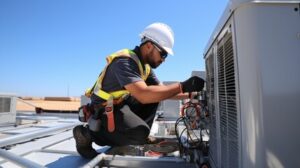The air conditioning system regulates the temperature of your home. Mechanical problems such as refrigerant leaks and airflow restrictions require timely repairs to reduce energy consumption and increase the lifespan of your AC unit.

Other issues such as electrical failures are also common and need to be addressed promptly. These issues often involve complex components that require professional repair services to resolve. Contact Air Conditioning Repair Henderson NV for professional help.
An air conditioning system requires regular maintenance and prompt repair to function optimally. This ensures the system is ready for the hot summer temperatures, allowing you to enjoy consistent cooling and comfort throughout your home. It also helps you save energy and money. A properly functioning AC unit also promotes indoor air quality and reduces the risk of respiratory problems and allergies.
Prompt AC repair also allows you to avoid costly repairs and prolongs the lifespan of your system. Ignoring any issue, even the most minor one, can cause a domino effect and put your entire HVAC system under strain. It may ultimately require expensive replacement parts or even system replacement. The best way to prevent this is by addressing any problem as soon as you notice it.
Unresolved AC issues lead to inefficient operation and higher energy consumption. This is because the system has to work harder and longer to cool your home. Ineffective performance also leads to the system wasting energy, contributing to energy waste and high utility bills.
With timely air conditioning repair, you can improve the system’s efficiency and performance, resulting in significant energy savings. You can achieve this by ensuring all components are in good working condition, such as cleaning the air filters, checking refrigerant levels, and inspecting the ductwork.
Inconsistent cooling and weak airflow are clear signs that your air conditioner needs attention. These issues can indicate that the system has clogged filters, low refrigerant levels, or a defective fan motor. A professional will help you determine the exact issue and resolve it quickly, restoring efficient operation.
An air conditioning system that is functioning at its best can help you enjoy a comfortable environment without excessive energy consumption. It can eliminate uncomfortable hot and cold spots in your home, as well as uneven temperature distribution. Timely air conditioning repair can also address problems with thermostats, refrigerant leaks, and airflow restrictions.
An air conditioning system that is in proper working condition ensures better indoor air quality by removing excess humidity and circulating filtered air. It also prevents odors, such as musty or burning smells, which can indicate electrical or plumbing issues.
Reduced Energy Consumption
The efficiency of an air conditioning system is key to reducing electricity consumption, and this can save home owners money on energy bills. Getting your air conditioner repaired when needed, improving home insulation and adopting energy-saving practices can significantly lower household power consumption. Some of the ways you can reduce energy usage include regularly cleaning or replacing your air filters, keeping your unit level so that condensation drains properly, and using appliances during off-peak hours.
The quality of indoor air has a direct impact on AC energy use, as airborne pollutants like dust, pollen and fur can increase the amount of energy required to cool a home. Air conditioning repair and maintenance services can address this by cleaning the evaporator and condenser coils, as well as ensuring that the external unit is kept clear of obstructions that could inhibit airflow.
Another way to reduce energy usage is by implementing zoning systems, which can improve home comfort by cooling specific areas according to their requirements. Installing a smart thermostat can also help optimize energy use by providing precise temperature control. Advances in air conditioning technology have also introduced features that improve performance and efficiency, such as variable speed fans, programmable thermostats, and advanced filtration systems. Embracing these technologies as part of your air conditioning repair and maintenance strategies can lead to significant savings in electricity costs (HowStuffWorks).
There are many other factors that contribute to energy usage, so it is important to check your utility bills to ensure you are not paying for more than you need. For example, you should be sure to switch off electrical appliances when not in use and unplug them at the wall outlet as this will significantly reduce standby energy use. Moreover, it is a good idea to invest in insulation to keep your home cooler and lessen the need for excessive air conditioning use during the summer months. Finally, consider asking your local utility provider for discounts and budget billing to avoid huge spikes in energy bills during the summer. A company like One Hour Air Conditioning & Heating offers prompt air conditioning repairs, and their focus on education empowers homeowners to make informed decisions that contribute to efficient home energy usage.
Increased System Lifespan
Incorporating regular air conditioning repair into a comprehensive maintenance program enables homeowners to extend the lifespan of their systems. Addressing small issues promptly enables the system to operate efficiently, which reduces stress and strain on the components. This creates a beneficial cycle where improved system longevity enhances home comfort while lowering energy bills, increasing a property’s value, and improving indoor air quality.
A system that experiences frequent breakdowns and malfunctions may require costly repairs or even total replacement much sooner than one that is properly maintained. By scheduling routine inspections with trained professionals, homeowners can identify and address potential problems before they escalate into more serious ones. For example, a minor refrigerant leak that is not addressed may quickly cause the compressor to overwork and ultimately wear out more rapidly than it should.
The most significant impact of timely AC repair is the resulting enhanced efficiency and reduced energy consumption. Inefficiently functioning systems consume more energy to provide the same level of cooling, resulting in higher utility bills and a greater financial burden on the homeowner. By conducting regular professional inspections, HVAC technicians can keep the air conditioner running smoothly and efficiently, which lowers energy usage, saving homeowners money in the long run.
Moreover, air conditioning repairs allow homeowners to improve their indoor air quality by eliminating impurities and pollutants that circulate throughout the property. Dirty filters and coils obstruct airflow and interfere with heat exchange processes, forcing the system to work harder to maintain comfortable temperatures. Maintaining clean filters and ducts eliminates this unnecessary strain, further prolonging the lifespan of the air conditioner.
Lastly, advanced air conditioning technologies offer an array of innovative features that further improve the comfort and energy efficiency of homes. These improvements include variable speed fans, smart thermostats, zoning systems, and advanced filtration systems. These upgrades make the air conditioning system more effective, efficient, and environmentally friendly, transforming the living space into an optimally comfortable environment. Including these advances during timely air conditioning repair and service allows homeowners to experience the full benefits of the latest innovations in the industry.
Comfortable Indoor Environment
A comfortable indoor environment is important for personal and organizational well-being. This is because it enables individuals to work and concentrate more effectively, reduces stress levels and enhances a sense of personal control. In addition, comfort can help to foster emotional stability and a sense of purpose and fulfilment.
Comfort is subjective and based on various factors such as individual preferences, environmental, work-related and personal conditions. To achieve a comfortable indoor environment, ventilation and air conditioning needs to be properly adjusted. This ensures the air is properly conditioned, removes bad smells and replenishes oxygen.
This is particularly crucial during spring, which can bring unpredictable weather. A sudden cold snap can leave your home feeling chilly, while a heatwave may increase your cooling needs. With timely air conditioning repairs, you can maintain a comfortable indoor temperature regardless of the changing weather. Keeping your air conditioner in good working order will help to keep you and your family healthy throughout the season.

